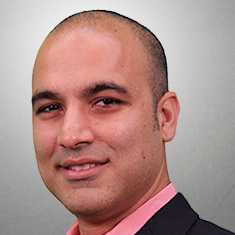
What did you do prior to attending (what is now known as) SBMI?
I was a medical graduate from overseas who was lucky enough to have worked with a wide variety of clinical care systems. I had been involved with some of the most sophisticated health delivery systems and watched patients and providers suffer from a lack of poor system design in those institutions. Additionally, I had the fortune to work with the International Organization for Migration and witness some of the smallest, most remote clinics deliver the promises of healthcare to so many underserved and indigenous populations because of intentional design and well-thought-out work flows. All of these experiences inspired me to learn more about how well-thought-out design and technologies could help bridge the gap in making the provider and patient experience a better one.
What drew you to health informatics? How did you initially get into the field?
My story is a simple one. I started from the bottom and worked my way up. The Texas eHealth Alliance had an internship for participants interested in a career in Health IT. I signed up and was appointed as an intern to the West Texas Regional Extension Center in Lubbock, TX. Reluctantly, I left for this remote bastion in West Texas, but to my amazement I had discovered that the same rural, resource-deprived providers I worked with overseas, could be found in rural West Texas. They were eager to improve their reach to patients across their region through the effective use of Electronic Health Records (EHR), and supporting technologies. With ARRA legislation passed and 18 billion dollars available for providers to adopt, implement and Meaningful Use and EHR, the opportunity to contribute and learn as an intern was palpable. During my time as an intern and later as the Director of Clinical Informatics at Texas Tech University Health Sciences Center, I was exposed to three hundred EHR implementations across west Texas in both the tiniest clinics in the panhandle to the largest health systems in this massive geographic area. Through it all, I learned some valuable lessons that have stuck with me throughout my career in Health Informatics.
How has the field changed since you graduated?
Since my graduation in 2012, we have seen wide-spread adoption of electronic health records and an improved understanding of electronic information and the opportunities/risks such information presents to providers and patients. In 2015, we are finally beginning to truly “meaningfully use” these systems to improve the delivery of care. For all of these efforts, I think providers, now more than ever, have a better understanding of the care they’re delivering and recognize the areas to improve.
What did you do after graduating, and where are you now?
I served as CMIO for a Health IT consulting firm for two years that was focused on helping hospital systems implement and optimize their Electronic Health Records. Since that time, I have transitioned into my current role as a Clinical Informaticist with Memorial Hermann Medical Group here in Houston. Many of the lessons from SBMI in regards to usability, data visualization, workflow analysis, and good data management practices support my everyday work.